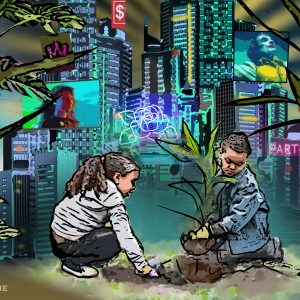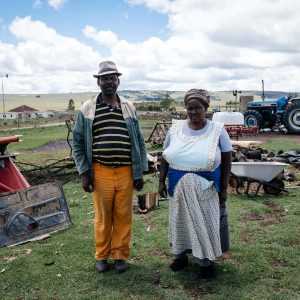Land redistribution has become ‘elite capture’
South Africa’s land reform programme was supposed to ensure that the impoverished get to own and work the land. Now, only the politically connected and economically included are benefitting.
Author:
6 August 2020

The majority of actual beneficiaries of land reform to date are from the urban middle class, according to the Institute for Poverty, Land and Agrarian Studies (Plaas). The institute says this is “elite capture” of the land and has effectively redirected state resources, originally intended for the impoverished, to the better-off.
Public resources have been targeted at those who can afford to engage in the conventional practice of large-scale farming and the bias has been changed to pursue commercial success instead of land redistribution. The result is that land reform policy has been directed away from small-scale farmers, effectively defeating the aims of land redistribution spelled out in the Constitution. Pro-poor precepts of land reform have increasingly been abandoned in favour of redistributing land to those who have already proved that they have the resources to achieve commercial success in their farming ventures.
At a recent webinar to mark the 25th anniversary of Plaas, its founder, emeritus professor Ben Cousins, and its lead researcher on land reform, Farai Mtero, warned that land reform has become the preserve of the well-off, with 44% of beneficiaries being urban-based “business individuals, taxi or transport operators, former state bureaucrats and local politicians with access to material resources, knowledge and information”. Their economic and political influence has enabled them to diversify into farming. And most of them, more than 80%, have been men.
The result is that only 18% of the 66 farms that Plaas studied were allocated to farm workers, many of whom encountered huge obstacles to success and have left their unsuccessful farms to seek employment elsewhere. A significant decline in systematic research on the outcomes of land reform, especially in the wake of the focus on Covid-19, says Plaas, confirms that elite capture in land redistribution has become firmly entrenched in South Africa.
Related article:
Mtero and his team conducted intensive fieldwork at seven sites in five provinces: Eastern Cape, Free State, KwaZulu-Natal, North West and Western Cape. They found clear evidence pointing to skewed distribution of resources in the land redistribution programme. Plaas says the well-off now often qualify as beneficiaries due to “policy biases which prioritise commercial success as an overriding goal in land reform”.
Mtero points out that this comes at a time of significant budget cuts in land reform programmes, alongside “a perennially low land reform budget, which has persistently been below 1% of the national total budget”. He says existing land reform legislation, such as the Land Reform, Provision of Land and Assistance Act 126 of 1993, has proven to be “very inadequate when it comes to assuring adequate access to land in South Africa … there are wide discretionary powers that are afforded to the administrative authorities in determining the allocation of resources. In other words, there is no formula to apportion the distribution of resources.”
Mtero points out that the Constitution directs the state to broaden opportunities for people to derive benefits from land, and this should include the right “for people to produce their own food”. “The right to land and the right to food [are] integrally linked. They are inseparable. They are interconnected,” he says.
Elite capture of land
The Plaas research team gathered data on 66 land reform projects across the country and found that “land reform has shifted from being pro-poor to being pro-elite”. The question, then, is: who has benefitted from land redistribution in South Africa? Who are the winners and who are the losers?
Elaborating on the concept of elite capture of the land, Mtero says, “[It] simply refers to the concentration of public resources in the hands of a few individuals, and usually it’s the economically powerful and the politically influential individuals. Instead of broadening access to land and reconfiguring the unequal agrarian structure, a select group of black commercial farmers is promoted in land reform.”
In the study, Mtero and his colleagues found that a majority of land recipients have basically dropped out of production as a result of a number of constraints on their farms, mainly lack of production support, poor infrastructure and rundown farm houses. These people, Mtero says, fall under the “dropping out category”. This is largely on account of “powerful people intercept[ing] resources, so that they don’t reach the rightful beneficiaries”. In the absence of resources and support, many have abandoned the farms allocated to them and moved elsewhere to seek alternative livelihoods.
Related article:
About 16% are still hanging on. “These are farmers who are just really maintaining a foothold on the farm,” says Mtero. This in spite of the fact that they still lack support and resources, such as machinery and production chemicals.
Fewer than a fifth of farmers who were allocated land are able to reinvest any surplus.
The strategy used by the elite is to move in on new business that have nothing to do with land but which they can use to divert resources into acquiring land. This results in the concentration of resources in the hands of a few powerful individuals.
“There is the imposition of politically connected beneficiaries; there’s the bailing out of politically connected elites who have accumulated debt in their farming enterprises; there’s the withholding of leases; there’s fronting; there’s also the exerting of political pressure on lower level officials so that they comply and flout departmental regulations,” says Mtero.
Agribusiness complicit
He says agribusiness is heavily involved in elite capture and describes how farms, even farm produce, are bought at a very low price and resold to the state at a very high price. Assets are transferred to partners or rented out to other farmers, including what he calls “strategic partners”.
Capital is brought in from outside agriculture. “Politicians, civil servants, affluent professionals, have increasingly become more involved in agriculture. Across the continent, the middle class is moving into agriculture, diversifying their sources of income,” Mtero says.
Related article:
Instead of the agrarian structure being equitable, broad and inclusive, a few black commercial farmers now hold the concentration of public resources. What is lacking, he says, are the founding principles of land reform. The process must strive to apportion resources in an equitable manner, so that historically disadvantaged groups, the marginalised, women, the youth, farm workers and dwellers can also benefit from land reform in South Africa. “The accumulation that we see is not based on the inclusion of the smallholder farmers,” says Mtero.
Approximately 250 000 small-scale farmers out of the total of 2.5 million small-scale farmers actually produce surplus food. The rest produce only for household consumption.
Job creation potential of land
Cousins’ study, commissioned by the European Union’s Capacity Building Programme for Employment Promotion (CBPEP) for the government’s Technical Advice Committee, focuses on the potential for job creation on the land. It concludes that land set aside for reform would be more effectively utilised if it were further divided into smaller pockets enabling small-scale farming to play a significant role in tackling the challenges of unemployment and food security.
This research was based on a model in which 50% of available agricultural land was redistributed. Focusing on four local municipalities – in Eastern Cape, Limpopo, KwaZulu-Natal and Western Cape – it found that more than 23 000 jobs could be created in these municipalities.
Related article:
As the Covid-19 pandemic rapidly corrodes employment, Cousins’ project findings may suggest ways to get South Africans working towards self-sufficiency.
“Successful land reform and rural development could dramatically improve the quality of life of the many rural residents who make up one-third of South Africa’s population, by boosting jobs, fostering economic opportunities and opening up access to markets,” says Cousins.
By carefully selecting beneficiaries and strategically pairing them with the right farming opportunities, jobs would be created.
He found, for example, that KwaZulu-Natal’s Inkosi Langalibalele Local Municipality, which focuses on livestock production, could increase employment by about 2 200 by farming mainly goats. Rearing goats is more labour-intensive than other forms of livestock farming. This would come at a cost of an estimated R325 000 per job, which includes the price of procuring the land.
In Limpopo, where high-value subtropical fruits and nuts are grown in a labour-intensive process, Cousins says, “We estimated the total new jobs which could be created through redistributing 50% of farms, commercial farms, would be around 17 000, at an overall cost per job of R418 000.” These estimates include the cost of the land.
In the Western Cape’s irrigated lands along the Oliphant’s River where high-value crops such as grapes and vegetables are grown, Cousins estimated that about 3 198 new jobs could be created. The relatively high cost of R680 000 per job is due to the higher price of land in the area.
“The selection of beneficiaries and matching them with opportunities is absolutely key … What is key here is to move away from the relatively wealthy and elite to those smallholder-based farmers, using mostly family labour and the small-scale commercial farmers who are going to invest in farming itself.”




